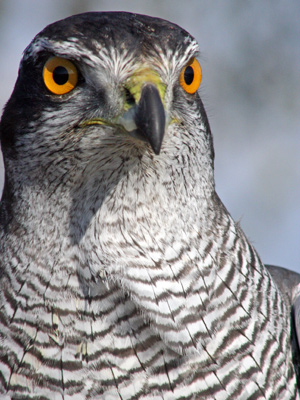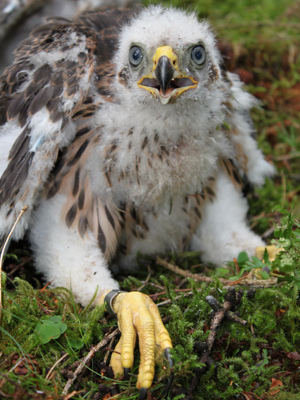Goshawk

The goshawk used to be widespread throughout Great Britain but became extinct in the late 19th century due to deforestation followed by relentless persecution.
They were reintroduced from the 1960s onwards, not by any conservation organisation, but by falconers and hawk-keepers who brought birds into the country initially from Poland and Germany, then subsequently in the 1970s from Finland (Petty 1996). Some of these imported birds escaped from captivity and others were deliberately released, to establish wild populations for harvest. These released and escaped birds established scattered populations throughout the country (Marquiss & Newton 1982).
The United Kingdom population has now increased to around 500 pairs and of these, Scotland has at least 150 pairs. The main populations in Scotland are in the north-east, in the Scottish Borders and in Dumfries & Galloway.
The Scottish population has benefited from the large forests such as those owned by the Forestry Commission. Here there is no persecution and the birds nest with little disturbance. However, despite the high level of legal protection given to the goshawk, its spread from these large forests into some of the surrounding privately owned woodlands has been restricted due to persecution. Goshawks regularly occupy these woodlands but many are killed after capture in cage traps set legally for corvids. Those that evade capture attempt to breed but some are then shot at the nest so breeding in these woods rarely persists for long.
Goshawks build a substantial nest in forests and large woods where there is little disturbance. They will return to the same nesting area each year where they will build a new nest, or alternatively refurbish and re-use an old nest.

For such a large bird they can be particularly elusive and secretive and can remain in an area for some time without being detected by the casual observer. However at certain times of the year they can be very noisy, in the spring when they are establishing their nesting territory and also in the late summer when fledged young are calling for food.
They will take a wide variety of birds and small animals as prey, birds as small as goldcrests to those as large as pheasants. However about two thirds of their diet consists of wood pigeons, crows, rooks and rabbits.
Their reputation for taking gamebirds has led them to be the victim of widespread persecution (Petty 2002, Marquiss et al. 2003). This killing prevents the establishment of breeding birds in areas managed for gamebirds, but also such persistent removal of potential recruits restricts population spread into suitable habitats elsewhere in Scotland (Francis & Cook 2011).
DNA research into goshawks is currently taking place and this will allow us to build up a better picture of the species’ population genetic structure, its dispersal from nesting areas and also the relationship between different birds within the population.
Malcolm Henderson & Mick Marquiss
References:
Francis, I. and Cook, M. (2011). (Eds.). The Breeding Birds of Northeast Scotland. Scottish Ornithologists� Club, Aberdeen.
Marquiss, M. and Newton, I. (1982). The Goshawk in Britain. British Birds 75: 243-260.
Marquiss, M., Petty, S.J., Anderson, D.I.K. and Legge, G. (2003). Contrasting population trends of the Northern Goshawk (Accipiter gentilis) in the Scottish/English Borders and North-East Scotland. In Thompson, D.B.A., Redpath, S.M., Fielding, A.H., Marquiss, M. and Galbraith, C.A. (Eds.). Birds of Prey in a Changing Environment. Scottish Natural Heritage & The Stationary Office, Edinburgh, UK. Pp. 143-148.
Petty, S.J. (1996). History of Northern Goshawk Accipiter gentilis in Britain. In Holmes, J.S. and Simons, J.R. (Eds.). The Introduction and Naturalisation of Birds. The Stationery Office, London. Pp. 95-102.
Petty, S.J. (2002). Northern Goshawk Accipiter gentilis. In Wernham, C.V., Toms, M.P., Marchant, J.H., Clark, J.A., Siriwardena, G.M. and Baillie, S.R. (Eds.). The Migration Atlas: Movements of the Birds of Britain and Ireland. Poyser, London. Pp. 232-234.
Scottish Raptors• Honey-Buzzard• Red Kite• White-Tailed Eagle• Marsh Harrier
Hen Harrier• Goshawk• Sparrowhawk• Common Buzzard• Golden Eagle
Osprey• Kestrel• Merlin• Hobby• Peregrine Falcon• Barn Owl
Tawny Owl• Long-eared Owl• Short-eared Owl• Raven
